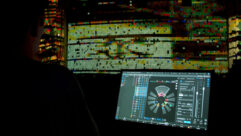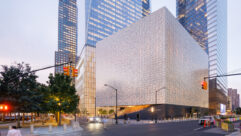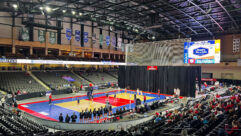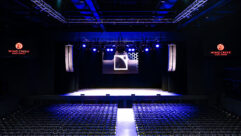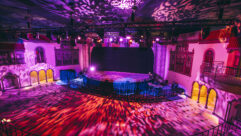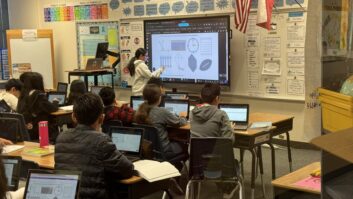On this edition of the SVC Podcast, Contributing Editor Bennett Liles wraps up his talk with Brian Bird, Audio Director at Lindenwood University in St. Charles, Missouri. Brian gets into the details of the L-Acoustics Kara system installation at the university’s Lindenwood Hall. The Soundvision modeling software is explored along with the training of students in audio technology and sound system design.
Links of Interest:
· Lindenwood Theater in the J. Scheidegger Center for the Arts
· L-Acoustics Soundvision modeling software
· A promotional video on the Lindenwood University Theatre Program
At Lindenwood University’s J. Scheidegger Center for the Arts, the Lindenwood Theater needed a new sound system to keep up with the demands of teaching sound design and the needs of touring performers. Audio Director Brian Bird is back this week to tell us about the installation and using the L-Acoustics Soundvision software. That’s coming up on the SVC Podcast.
Brian, I appreciate your getting back with us for Part 2 on the SVC Podcast coming to us from Lindenwood University in St. Charles, Missouri. We’ve been talking about the Lindenwood Theater which is just part of the J. Scheidegger Center for the Arts. The theater sound system was upgraded with an L-Acoustics Kara system. Tell us about the components of that new sound setup.
Sure. So it was kind of co-designed by myself and a couple of the guys at Logic Systems just kind of tweaked that design for me, so a bit of a team effort there. But we ended up with 24 total Kara boxes, another eight SB18 subs along with four – 5XT’s and four 112P’s. The Karas are configured in a left/center/right configuration with nine boxes per side on the left and right, another six in the center, and the subs are split up with three SB18’s per side on the left and right. And from time to time we use two more in the center if we need a little bit more punch out of the center. Sometimes there’s just no subs in the center; it just kind of depends on the show. And then we use four 5XT’s for front fills and we have four 112P’s as surrounds in the theater to allow us to do 5.1 surround either for a movie if we’re showing it or, in most cases, it’s utilized when we’re doing theatrical events and musicals. [Timestamp: 2:01]

Yeah, those small 112P’s are pretty versatile and I’ve seen them used in several ways on big systems. Are they used anywhere else say, along the front of the stage?
No, they’re in the back of the house, used as surrounds on the left and right – both on the lower level and the upper level – to give you a full surround sound system in the space where you can really spatially spread things out for theatrical events and really put the audience in the show from a sound perspective. [Timestamp: 2:25]
And in order to design the system you worked with the L-Acoustics Soundvision modeling software. I would think that you had the opportunity to get pretty good with it so how does the Soundvision modeling software work?
Well, Soundvision is similar to CAD. I don’t know for sure, but I’d be surprised if it doesn’t work over a CAD shell but it’s way simpler. [Laughs] For those of us who are not real fond of CAD and CAD drawings it allows us to put measurements in. And if you put the accurate measurements in of the room and you can really model that room in 3D. I mean, you see the stage, you see where the seating areas are, walls, etc. That, then, allows you to place the L-Acoustics speakers. You can pick from a list and put them in the space and then you, using an X, Y and Z axis, put it exactly where you want to in the room – both height, distance from center, right at the edge of the stage, etc. And then you can actually run some functions in there that show exactly how it’s going to interact in the room, how much energy you’re going to have on the walls, where the coverage is in the seats, if there’s going to be hot spots, what they are. You can play around with the angles of the boxes and their positioning a little bit to get the best coverage in the space with the least amount of energy in places you don’t want it. And, you know, you try different things. And it allows you to delay subs, for example, so you can see how your sub array will cover if you want to do a sub arc and delay those, things of that nature. It’s real in-depth and it’s super accurate. What you end up getting once you put the speakers in and you listen to it is really what you saw in the model, which is super important. There’s some modeling software out there that is somewhat accurate and then there’s modeling software out there that’s spot on these days and Soundvision is one of those. It’s really spot on. It’s amazing how accurate it is. [Timestamp: 4:18]
You probably have different configurations that you can dial up on it depending on what’s going on at the time and likely the most frequent thing is teaching classes. I guess that’s one of the less challenging ones. If you’ve just done a class and then you have a touring act come in that night, what do you do as far as setting it up differently?
Well, I mean physically you can move the boxes wherever. We ordered it with the touring hardware, so you can change things around. And the modeling software, again, will tell you if you have too many boxes in an array. In other words, too much weight for the angle you’re trying to get, things like that. It will let you know that that’s an unsafe weight load or workload on that particular set of boxes so that helps. But then as far as presets and whatnot with the amplifiers, yeah, our basic presets have running subs on an aux or running subs as the left/right. We set up our system with AES driving it and then an analog fallback so if the AES were to fail it will fall back to analog. But the students get to play around virtually not only in our space, but one of the things L-Acoustics has on their web site is a huge catalog of other venues around the country. And so you can download those venues and you can put speakers in there and see how they would react in there based on where you hang them – the speakers. It’s super helpful for touring guys, but it’s also really helpful for us that are teaching it because our students can really understand that hey, this box works better in this size space and this one works better in this size space and here’s why. And so it’s been great to be able to teach virtually without having to move the boxes around all the time. We do it from time to time so that we can realize a design when the schedule allows. But the presets on the amplifiers are great for different configurations and different guest engineers that prefer to drive the rig differently. [Timestamp: 6:10]
And you have a balcony in there and one of the more difficult spaces to cover might be under the balcony. How do you manage that?
Well, for us it really wasn’t that difficult. We have a lower hang of our PA so it covers under the balcony real well. Our biggest challenge was not getting reflection off of the balcony face. And so we accomplish that by essentially taking each of the clusters and splitting them up into essentially two clusters. You have to have enough boxes – in this case it was three that just worked right to throw enough distance and cover the balcony real well. So really, the top three boxes on the left and right hangs are covering the balcony where the bottom six are covering the floor and the parterre areas. And there’s a pretty big angle between Box 3 and Box 4 on that hang that allows us to keep a lot of the energy off of the front of that balcony and reduce reflection. [Timestamp: 7:04]

When you brought this new system in were there any electrical changes that you had to make in the theater to support it? Did you have to add capacity or anything?
Well, we’re pretty beefy when it comes to electrical. We’re pretty lucky there. We’ve got isolated power for audio that’s wired throughout the building in all of our venues. We even have isolated power in the lobby and a couple of other places for when we do events so that we’re not on the power of our kitchen or anything like that for catering. We did pull about six circuits up to the room where we house the LA8 amps in order to power those off the isolated power. It was pretty simple. It happened to be the room right above one of our main electrical rooms that had a big isolation panel already in it, and so we were able to tap into that. But there was some minor electrical work that had to be done that was taken care of by our in-house electricians. [Timestamp: 7:53]
Well, that’s not so bad so how long did you have to get the whole project done and ready to go for the first production?
Well, our schedule is really tight at the Scheidegger, with the exception of summer. So initially we had thought about a summer installation. That didn’t happen. There were some delays with board approval and things like that. So we ended up doing a January install and we only had about a week that we could be in the facility installing, which turned out to be way more time than we needed. Logic did a great job of the prep on the front end of it; amp racks were already built, a lot of cable pre-terminated and things like that. Came in and in a day and a half it went from nothing to the system was tuned and ready to go and commissioned. [Timestamp 8:38]
And that’s Chip Self’s local outfit, Logic Systems Sound and Lighting.
Logic Systems Sound and Lighting, yeah. They’re a large production company here in the St. Louis area. [Timestamp: 8:47]
OK and it’s got to be fun once you have everything up and running to turn the students loose on it and see what they can do. So how is that when you give them their first taste of getting their hands on the controls?
I’ll tell you what. When they first start mixing live music, whether it’s in a pit orchestra or a band, on that system – they all play around with it a little bit with tracks and with their CD’s or mp3 files these days, not CD’s. But they play around with it a little bit there and they’re kind of impressed. The low end, in particular, on this system, those SB18’s, are just amazing. And that will impress them a little bit. The first time they mix on that live compared to other systems they’ve been on, the smile that’s on their face and the excitement that they can really hone in and get what they want sound-wise, it’s like a blank canvas. It gives you that creativity to do whatever you need and just a great system. So they get really excited about that and I get excited watching them get excited. [Timestamp: 9:44]
Now that you have all that going, what productions do you have coming up in the Lindenwood Theater?
Well, we just finished Rick Springfield over the weekend. And Matty, Rick’s front of house guy, was extremely happy with the rig. We’ve got Waka Flocka Flame coming up next weekend. Over the next couple of months we’ve got a couple of dance concerts, our winter dance concert and our spring dance concert, for our dance department. We’ve got the St. Louis Philharmonic Orchestra that will be performing, a couple of music weeks over the next couple of months. Our music department does a bunch of concerts – orchestra and choir and jazz concerts. And we’ve got, in our touring series to wrap up our season, we have Patti LaBelle, we’ve got Patti Lupone and Trace Adkins to finish that out. We’ve also got a couple of big theater productions coming up, The Rocky Horror Picture Show and Our Town will be performing in the space as well before the year is out. [Timestamp: 10:39]
That’s sure enough to keep everybody busy and you’re ready for it with the new L-Acoustics system. Nice of you to tell us all about it. It’s Brian Bird, Audio Director at Lindenwood University in St. Charles, Missouri. The J. Scheidegger Center for the Arts. Thanks for the story on it.
Thank you for having me. Happy to.
Lindenwood Theater has moved up to a more modern sound system to better serve the students and visiting performers. Thanks to Audio Director Brian Bird for telling us how the whole project got done. Next week we’ll have another AV installation story so get with us for that on the SVC Podcast.


